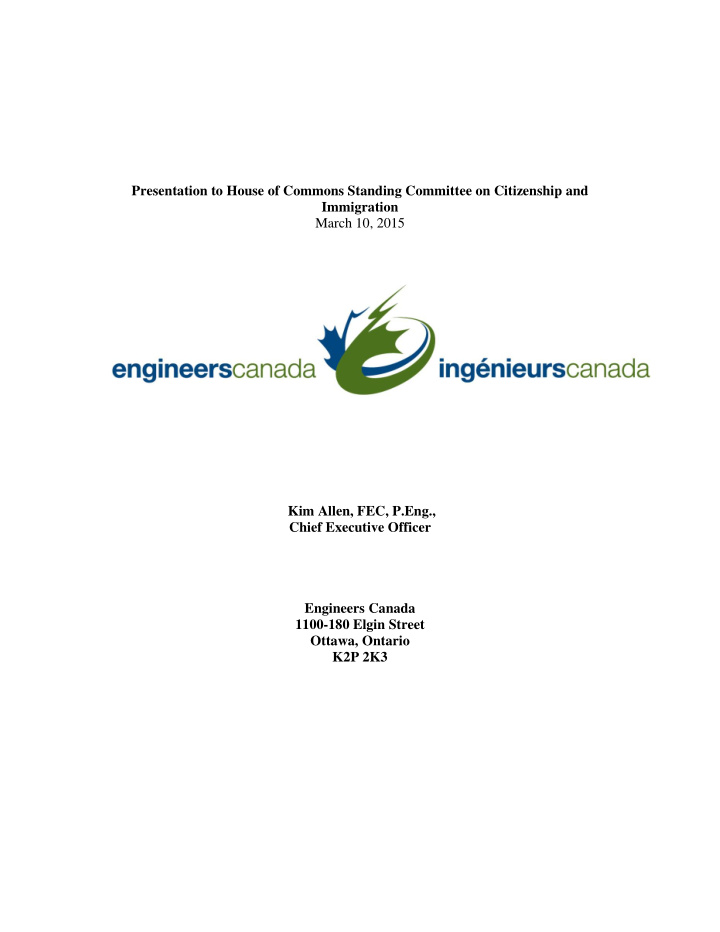



Presentation to House of Commons Standing Committee on Citizenship and Immigration March 10, 2015 Kim Allen, FEC, P.Eng., Chief Executive Officer Engineers Canada 1100-180 Elgin Street Ottawa, Ontario K2P 2K3
2 CHECK AGAINST DELIVERY Thank you for the opportunity to appear today. I am pleased to be here both as the Chief Executive Officer of Engineers Canada - the national body that represents the provincial and territorial regulators of the engineering profession, and as a member of the Panel on Employment Challenges of New Canadians. Canada’s success requires skilled immigrants. Ensuring that new Canadians reach their fullest potential is a complex social policy challenge. In our multicultural, democratic, market-driven country, addressing these challenges requires multi-stakeholder actions to get the best outcomes for all involved. We have all heard about a professional from abroad who comes to Canada and can only find work well below their economic potential. For the engineering profession, this is a particular tragedy. We are experiencing a shortage of engineers with 5 to 10 years of experience or specialized skills in most regions of the country. By 2020, we expect about 70,000 new engineering graduates in the workforce, and around 50,000 qualified newcomers. This is a significant number of engineers. We cannot let their skills and knowledge be underutilized. Engineering is a broad field, offering a wide variety of career options. These skills are in high demand in many areas of our economy. While many engineering graduates practice engineering, even more become entrepreneurs, business executives and enter fields like information and communication technology, marketing, banking, or consulting. In fact, by mid-career about two-thirds of engineering graduates are applying their skills more broadly than practising engineering in traditional and emerging disciplines where public accountability is required. We need focused attention by the profession, employers, academia and governments now to address this problem. For over a decade Engineers Canada and the engineering regulators have worked with government, immigrants, academia and others to address the chronic problem of newcomers under-utilizing their skills and knowledge. Much of what we have heard from international engineering graduates, industry, and regulators is consistent with what my colleagues on the Panel on Employment Challenges of New Canadians have heard through our meetings with over 160 stakeholders. The good news is that there are various programs and information sources available through many organizations that can help engineers and others find their way. The bad
3 news is that it can be a confusing landscape, especially for those who wish to work in regulated professions. Regulated professions like engineering have already improved the available information on how to navigate the licensure process. The federal government’s Express Entry system, and the requirement for an assessment of educational credentials for certain economic class immigrants, will help also help immigrants understand where their skills and knowledge fit in the Canadian economy. Engineers Canada ’s Roadmap to Engineering in Canada provides guidance on the licensure process, and provides potential immigrants with a sense of whether their academic qualifications will make them eligible to apply for licensure. It also provides information on building a resume and understanding the engineering job market. We hope to be able to successfully link this rich information with the educational credential assessment process that is part of the Express Entry immigration system. But there is more to do beyond better connecting regulated professions and immigration processes. We are continuously working to improve the quality and detail of the information available to newcomers - upon arrival, and pre-arrival in the decision-making phase. Immigrants need clear, concise, easily-accessible information about the regulatory landscape and foreign credential recognition so they can plan for their success in Canada. Beyond licensure, immigrants need to know more about the economic landscape as well. Our labour market data shows that the demand for engineers is higher in some parts of the country than in others. The jobs that can improve economic outcomes for newcomers may not be in the communities they would intuitively immigrate to. Helping newcomers make realistic decisions about their plans in Canada requires consistent, detailed labour market information that is easily accessible and current. Immigrants and newcomers shouldn’t have to cobble together a picture of where the best opportunities in their field exist. Up to 16,000 new engineering jobs will be created in Canada between now and 2020. Employers, regulators, academia and governments have a responsibility to work together to provide newcomers with information on where those jobs are likely to be located, and what skills and competencies are going to be most in demand. As I said at the outset, the Panel traveled the country and received many submissions. The good news is that there is a stakeholder community made up of immigrant-serving agencies, regulators, academia, federal, provincial and municipal governments, and other community groups ready and willing to help newcomers succeed.
4 The more we all work together to provide the best information and guidance to new Canadians at all stages of their journey, the better outcomes immigrants, the engineering profession, and Canada as a whole will have. Thank you again for the opportunity to speak with you today. I would be happy to take any questions you may have.
Recommend
More recommend